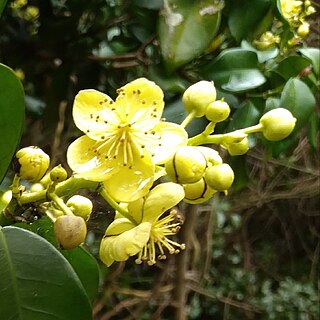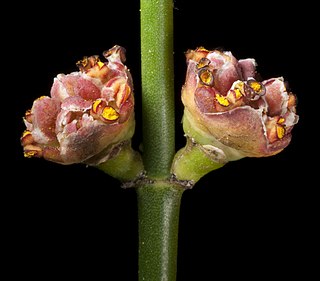
Mallotus is a genus of the spurge family Euphorbiaceae first described as a genus in 1790. Two species are found in tropical Africa and Madagascar. All the other species are found in East Asia, the Indian Subcontinent, Southeast Asia, eastern Australia, and certain islands of the western Pacific. The genus has about 150 species of dioecious trees or shrubs.
Colobocarpos is a monotypic plant genus of the family Euphorbiaceae. The sole species is Colobocarpos nanus. It is native to Laos and Northern Thailand.

Sampantaea amentiflora is a plant species of the family Euphorbiaceae, first described as a genus in 1972. The genus Sampantaea is monotypic and found in Thailand and Cambodia.
Necepsia is a plant genus of the family Euphorbiaceae first described as a genus in 1910. It is native to Madagascar and to tropical Africa.
- Necepsia afzeliiPrain - Liberia, Sierra Leone, Ivory Coast, Ghana, Cameroon, Congo, Cabinda, Gabon
- Necepsia castaneifolia(Baill.) Bouchat & J.Léonard - Tanzania, Zimbabwe, Madagascar
- Necepsia zairensisBouchat & J.Léonard - Congo, Zaire
Paranecepsia is a plant genus of the family Euphorbiaceae first described as a genus in 1976. It contains only one known species, Paranecepsia alchorneifolia, native to southeastern Africa.
Cheilosa is a monotypic plant genus of the family Euphorbiaceae first described as a genus in 1826. Only one species is recognized: Cheilosa montana, native to Southeast Asia.

Doryxylon is a monotypic plant genus in the family Euphorbiaceae first described as a genus in 1857. The sole species is Doryxylon spinosum. It is found on the Island of Luzon in the Philippines and in the Lesser Sunda Islands of southern Indonesia.
Cephalocroton is a genus of plant of the family Euphorbiaceae first described as a genus in 1841. It is native to central, eastern, and southern Africa from Nigeria and Ethiopia south to KwaZulu-Natal.
Cephalocrotonopsis is a genus of plant of the family Euphorbiaceae first described as a genus in 1910. It contains only one known species, Cephalocrotonopsis socotranus, endemic to the Socotra Islands in the Indian Ocean, part of the Republic of Yemen.
Cladogynos is a genus of shrubs in the family Euphorbiaceae, first described as a genus in 1841. It contains only one known species, Cladogynos orientalis, native to Southeast Asia and southern China.
Botryophora is a genus of plant of the family Euphorbiaceae first described as a genus in 1888. It contains only one known species, Botryophora geniculata, native to Thailand, Myanmar, Malaysia, Borneo, Sumatra, and Java.
Benoistia is a genus of shrubs or trees of the spurge family (Euphorbiaceae) and the monotypic subtribe Benoistiinae. It was first described as a genus in 1939. The entire genus is endemic to Madagascar. It is dioecious.
- Benoistia orientalisRadcl.-Sm. - N + E Madagascar
- Benoistia perrieriH.Perrier & Leandri - Madagascar
- Benoistia sambiranensisH.Perrier & Leandri - N Madagascar
Cyrtogonone is a genus of shrubs or trees of the spurge family (Euphorbiaceae), first described as a genus in 1911. It contains only one known species, Cyrtogonone argentea, native to tropical central Africa. It is dioecious.

Cavacoa is a plant genus of the family Euphorbiaceae first described as a genus in 1955. All the species are native to sub-Saharan Africa. It is dioecious.
- Cavacoa aurea(Cavaco) J.Léonard - Kenya, Malawi, Mozambique, KwaZulu-Natal
- Cavacoa baldwinii(Keay & Cavaco) J.Léonard - Sierra Leone, Liberia
- Cavacoa quintasii(Pax & K.Hoffm.) J.Léonard - Annobón, São Tomé, Zaïre
Grossera is a plant genus of the family Euphorbiaceae first described as a genus in 1903. It is native to Madagascar and to mainland tropical Africa. It is dioecious.
- Grossera angustifoliaBarbera&Riina - Equatorial Guinea
- Grossera elongataHutch. - Príncipe
- Grossera glomeratospicataJ.Léonard - East Congo
- Grossera macranthaPax - East Congo, West Congo, Cameroon, Central African Rep.
- Grossera majorPax - Cameroon
- Grossera multinervisJ.Léonard - East Congo, São Tomé
- Grossera paniculataPax - West Congo, Cameroon, Gabon
- Grossera perrieriLeandri - Madagascar
- Grossera vigneiHoyle - Ivory Coast, Ghana, West Congo
Tannodia is a plant genus of the family Euphorbiaceae first described as a genus in 1861. It is native to Africa, Madagascar, and Comoros. It is dioecious.
- Tannodia congolensis - Zaïre
- Tannodia cordifolia - Comoros, Madagascar
- Tannodia grandiflora - Diana Region in Madagascar
- Tannodia nitida - Atsinanana in Madagascar
- Tannodia obovata - Atsinanana in Madagascar
- Tannodia pennivenia - Atsinanana in Madagascar
- Tannodia perrieri - Madagascar
- Tannodia swynnertonii - Tanzania, Mozambique, Zimbabwe
- Tannodia tenuifolia - Kenya, Tanzania, Malawi, Mozambique, Zimbabwe, Zambia
Neoboutonia is a plant genus of the family Euphorbiaceae first described as a genus in 1864. It is the only genus in subtribe Neoboutoniinae, and native to tropical Africa. It is dioecious.
- Neoboutonia macrocalyx Pax - Burundi, Cameroon, Rwanda, Zaire, Kenya, Tanzania, Uganda, Malawi, Zambia, Zimbabwe
- Neoboutonia manniiBenth. & Hook.f. - tropical Africa from Liberia to Mozambique
- Neoboutonia melleri(Müll.Arg.) Prain - tropical Africa from Nigeria to Mozambique

Calycopeplus is a plant genus of the family Euphorbiaceae first described by Jules Émile Planchon as a genus in 1861. The entire genus is endemic to Australia. Its closest relative is Neoguillauminia from New Caledonia.

Neoguillauminia is a genus of plants in the family Euphorbiaceae first described as a genus in 1938. It contains only one known species, Neoguillauminia cleopatra, endemic to New Caledonia. Its closest relative is Calycopeplus from Australia.

Gymnanthes is a genus of flowering plants in the spurge family, Euphorbiaceae, first described as a genus in 1788. It is found primarily in the warmer parts of the Western Hemisphere, but with some species in central Africa and southwestern Southeast Asia.







